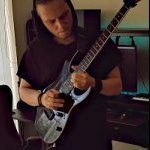Leaderboard
Popular Content
Showing content with the highest reputation on 10/26/2020 in all areas
-
Any preference you have for the sound of one Helix demo over another is due solely to the subjective nature of tone and/or the skill of the guy who created the patch and made the demo. Helix is Helix... Stomp, Native, Floor, or Rack is 100% irrelevant. They're all the same modeling engine.2 points
-
1 point
-
1 point
-
Volume/Pan -> Stereo -> Stereo Width with RPolarity set to Invert enhances the stereo width. Adjust with Width. This puts the stereo sides in paraphase. It's a strong effect. Use with caution: when you mix both sides to mono they cancel each other out and the sound disappears. Alternatively try this delay trick.1 point
-
I wasn't able to find a manual for your amp, but the product page on their website has a little blurb about midi that seems to explain it. http://www.sherlockamps.com/products/fat-head.html Select a patch number on the Fat Head Controller or any MIDI Controller. Select the amps channel or function using the corresponding buttons on the Fat Head. The led or leds on the Fat Head light up to indicate which channels or functions have been selected. Press and hold the “Prog” button for 2 seconds. The Fat Head will now save this combination and assigned it to the patch number selected on the Foot Controller (in step 1), and your done. What I get from this is that your amp receives MIDI Program Change (PC) messages. So on your Helix you would select a preset, adjust your amp's parameters then press and hold its "Prog" button for 2 seconds to save those settings. Now whenever you select that preset on the Helix, your amp should recall those settings. Unfortunately, as far as I can tell from this brief explanation on their site, your amp does not receive MIDI Continuous Controller (CC) messages, which is what C4TH's suggestion is using. Maybe there's a manual that contains a more in-depth explanation of your amp's MIDI implementation that includes a list of CCs that control individual parameters, but I can't find it.1 point
-
What you're trying to do is a very specific and not very common thing, therefore you shouldn't expect it to be a simple thing at all to set up, nor should you expect people on this forum to understand what you're trying to do and why. Personally I agree that it's probably not the best solution to your problem, but you've already decided that that's how you want to deal with it so I'll do my best to help you, but as someone who has over 20 years experience in studios, I know that no attempt to get a "final" sound is worth the effort before attempting a final mix. Chances are you're going to end up applying some kind of EQ to your guitar tracks in final mix stage anyway, no matter what you do at this point, and that's mostly because whatever compression and limiting you use on the master bus or any groups your guitars are in is invariably going to affect frequency response. It's just an inescapable fact of life that mixing is "itinerant", which means jumping from place to place. You'll never get a final guitar sound before you do the final mix EVER, and the best approach is always to get the best sound you can NOW, and make incremental adjustments as you get further down the line to deal with how the interaction with other elements change that sound. BUT... if you want to try and do what you want to try and do, yes, you can do it with the plugin and whatever your DAW calls Parameter Manipulation.1 point
-
Alright, in that case it surely makes no sense to work the way I suggested. :) I was assuming that there was a difference between the hardware units and the VST and the YouTube videos I watched confirmed that to me. Lesson learned: Better ask directly in the forum of the producer than to watch YouTube videos. :D I'll return the Stomp for Helix Native then.1 point
-
I would use an FX Loop block in the Helix preset. For stereo operation choose FX Loop 1/2. Connect the Send 1 and Send 2 outputs from Helix to your first stereo external pedal and connect the last stereo pedal’s outputs to the Helix Return 1 and Return 2 inputs. No need for multiple paths. Using the stereo FX Loop setup should maintain the stereo signal throughout the loop as long as all your external pedals are stereo and connected accordingly. If you want to use some of your external pedals at one point in the signal chain and the rest at another point you can use FX Loop 1/2 at one point and FX Loop 3/4 at a different point, connected as described above.1 point
-
The best option might be to use Helix Native, and use your DAW to link the controls on two amp blocks.1 point
-
I will respectfully "forget your intentions" and just answer your question. No.... it is the simultaneously part that makes it fall apart. Two guitar parts through separate instances will need to be controlled separately. Even if you run them through a single instance of Native (or the Helix) on separate paths, two amps are two amps. It appears the biggest hurdle you face is the amps because they have no "stereo version". Set your Helix up with all stereo effects, create a parallel path for the 2nd amp (amp 1 on the upper path, amp 2 on the lower path) and make sure the split & merge are panned appropriately. The effects will be simultaneous, but the amps will need to be controlled separately. If I can make just one suggestion.... When building stereo guitar tones, guitar should be treated as MONO IN > STEREO OUT, not STEREO IN > STEREO OUT There are exceptions to this... but normally that is simply how guitars work.1 point
-
Well.... I sold my Helix and got the axe FX 3 for about a year now. Yes, it kills Helix stock presets.... HOWEVER. I am still using my Native plugin and if you combine it with some good IRs from OH MLSL or other.... man ... this thing can sound soooo good. For me, axe3 is cool sounding with all its options, but its not as much comfortable to use as helix native is. Reamping with native is sooo easy and saves a lot of time. PLUS I canforce Helix native to sound exactly as Fractal AXE FX 3 unit. There is no difference in sound, native can produce exactly the same sounds if you know how to dial your tone. Honestly, AXE FX 3 has so many options etc, but 99% of the time I wont touch much settings. They are overwhelming at least. I have spend some days in the past turning the knobs on Axe3, but I ended up creating as much simple presets as I can. I wish that Fractal guys could brought their product as a VST plugin like Native, because atm I enjoy recording with NATIVE over the AXE FX 3. COMPARING SOTCK PRESETS is very unfair. AXE FX3 uses IRs in stock presets and Helix uses its own kinda lollipop sounding simulation of an IR. If you spend like 12 hours messing with stock cabs on Helix, than maybe you will get some decent sounds....maybe.... But load some cool IRs into Helix or Native and...... It can be on pair with Axe3. For me NATIVE is a winner in terms of price, easy of use and can sound like Axe FX 3. PERIOD. Native and Axe FX 3 as well, both can sound exactly like Neural dsp. Comparing the freedom that native has and the price point.... But people who don't know how to dial the sound they want will choose the neural dsp, because it sounds good straigh out of the box and they don't mind the limitations or obvious cash grabs with archetypes.... I do like how they sound but I have done a comparition and like I wrote before, both Helix and Axe 3 can sound exactly as Nolly's deafult preset.... The Neural DSP has this almost postproduction quality achieved by compressions and EQ within the signal chain, while both AXE and Native focus on delivering authenticity, which later can be processed to anyones likings. ALL OF THIS is my honest opinion. I own AXE FX 3 as on the picture below, I had Helix Floor and I am using Helix native with Focusrite interface. IMO Native is better than floor unit if you unlock its power by disabling the compatibility mode in options and combine it with a quality audio interface. With Native all you record is actually a DI, which can be modulated with native via FX block on your trac which is so easy and comformtable to do. With Axe3 on the other hand when you reamp you need to re-record the trac over and over again, after you made some changes, which is also nice option to have, but can take a lot of time if you are searching for the right tones...... The reason I sold Helix was that at that time I had no idea how to dial a good tone.... SAD BUT TRUE. So I went for AXE FX3. But now, after years of learning and experimenting I PROMICE TO YOU, if you know how to dial a tone you can get some crisp nice tones out of your old sneekers. So all comes down to what is more comfortable for you. I Paid for my axe fx 3 about £2.4k form G66 website in Europe, which is a rediculous price anyway.... For the helix native I have paid around £70 as a Helix floor user. I bought Helix floor for £1.2k and sold it for £900.... but anyway, giving that price difference between Native and AXE FX 3 and in the end they sound exactly the same while using same IRS..... well... Just think about it.... If you compare sotck presets, than obviously Axe is a winner. If you really want to nail something, like the difference between helix and axe3.... you will finaly do it. Axe might be the better product overall, as it has more IR memory, more presets, has more effects, can deliver more. But it is pricey. AND TO BE HONEST, within a mix content you will hear NO DIFFERENCE. If you can afford AXE than do it, why not. If you are clever and have no money (which is odd) but anyway can happen, (we have some extreemly lazy people out there ;d) than Helix Native is all you need. For its easy of use, flexibility, IRS and superb sound quality. Its the best VST out there, because it can replicate the sound of NeuralDSP, Bias2, Amplitube and most satisfactionary a real amp..... while being very flexible... I am not a fanboy of any of those products, I just simply tell my honest opionion based on my experience with recent technology. For a short time in the past I would call mysel Fractal fanboy, but later I realised If I am a fanboy, than definately I am a fanboy of current technology, because it saves me a lot of money, space and time by letting me use amp simulators and multieffects, which in the end sound as good or sometimes better than real rig and are joy to work with and record my guitars. I HOPE this will help many of you to make a decision. EDIT: Here are some YT comparision and sound examples, so PLEASE don't tell me that Helix sucks, because literally it means that you suck at dialing your tones.1 point
-
Hi, You are quite correct, I really can’t understand what you are trying to achieve with this, because having re-read your OP, I think you have already answered your own question. This is the point my confusion - if you have recorded dry guitar signals how/why is it a stereo input to the Helix. There are some exceptions but usually guitars are mono instruments until post amp stereo FX are added. Dazed and confused (once more).1 point
-
Hi, The reason that technique is in the manual is because it is the most simple, painless way of doing it, and your audio remains digital throughout. What you want to do will put the audio through a couple of unnecessary analogue/digital/analogue conversions, but hey, that’s the way you want to work with it, so fine. You simply need to take the clean guitar audio out from your DAW via your interface into the front end of your HX Stomp and then the effected signal back to your interface and into the DAW. Not overly complicated really, a bit of re-patching and there you have it. A small mixer would be a preference here, again that’s up to you. Furthermore, as you already have a clean guitar tracked, you could keep any further processing digital by using HX Native as a channel insert plug-in and thus allowing even more options as it has far more FX blocks available. No need to exit the DAW for Helix tones. Mmm... I didn’t realise that there is a general consensus of opinion that Native doesn’t sound as good as a Stomp. Surely some mistake. That quite simply defies logic. The whole reason that the HX Stomp exists is because the “brain” is derived from the Helix, which is the same as Native. I admit that my view may be somewhat biased as I have been using a Helix floor as a primary tool for recording and re-amping guitar tracks for five years. Plus I have being using HX Native as major plug-in since it first became available - not just for bass and guitar, you can use it on any audio that you want, e.g. vocals, drums, synths. Could be that my ears have been deceiving me all this time. I really should spend less time in the studio and trawl YouTube to find where I’ve been going wrong. Also, when asking for assistance, it would be a good idea to let us know what computer OS, DAW and interface you are using - that way we could probably offer other options and/or more suggestions. For example, how about the possibility of an aggregate USB device for recording and playback? Hope this helps/makes sense.1 point
-
Thank you guys so much for taking the time to respond to my post. The issue was with TotalMix FX on my part. I needed to mute a channel in it's mixer TotalMix FX. I would even make a video about what i was going through if i had the software and a camera to explain. Maybe in the future. Yeah commando the sound quality is big step up from a UX1. Thank you!1 point
-
Put a gain block and an EQ block into any empty preset and you effectively have an acoustic guitar amp.1 point
-
I have been using MIDI Guitar 2 to do this for a few months now. It works well enough for my purposes. To have what it does built right into the Helix would be fantastic.1 point
-
1 point
-
I'm 100% on board for more synth stuff. We have enough amps and effects unless they wanna throw us some more ambient/experimental type effects like glitching and stuff! To be honest I'm quite a bit let down about it not having more synth stuff considering how guitar synth stuff has exploded lately. I have a boss sy-1000 and gk pickups and can use external synths like my hydrasynth and wavestate etc... with it but it would be nice if helix got in the synth game. If helix could do great synths it would be powerful with that and variax. It would be a boss sy-1000 on steroids where you could conjure up awesome synth tones, acoustic guitar stuff, alt tunings, different modelled electrics and bass etc... I can do all that with sy-1000 but I'd love to be able to do it all in helix instead and be more powerful with 4 signal paths (instead of 3 in sy-1000) and more fx blocks in helix 32 (instead of like 15 in sy-1000) and helix routing and fx loops and stuff would just make it a killer over sy-1000. If helix got to the point of having strong polyphonic synth options that are great I would drop my gk pickups and sy-1000 and get my a variax but it would have to be much better than sy-1000 before changing. Able to sound good, split strings, great alt-tunings, good filters etc..1 point
-
The Synth options of the Helix are way too underdeveloped. I think we have enough amps and effects, i personally would even *pay* for a firmware with more synthetic stuff!1 point
-
Hey Guys, Today I have the explanation of the "Architects," tone I posted a few days ago. I had a lot of fun with this one. I used two Ownhammer Impulses OH 412 TRAD V70 121-00 and OH 412 TRAD V60 OH1F-05 Thanks so much for all the support, positive comments and input.1 point
This leaderboard is set to Indiana - Indianapolis/GMT-04:00




